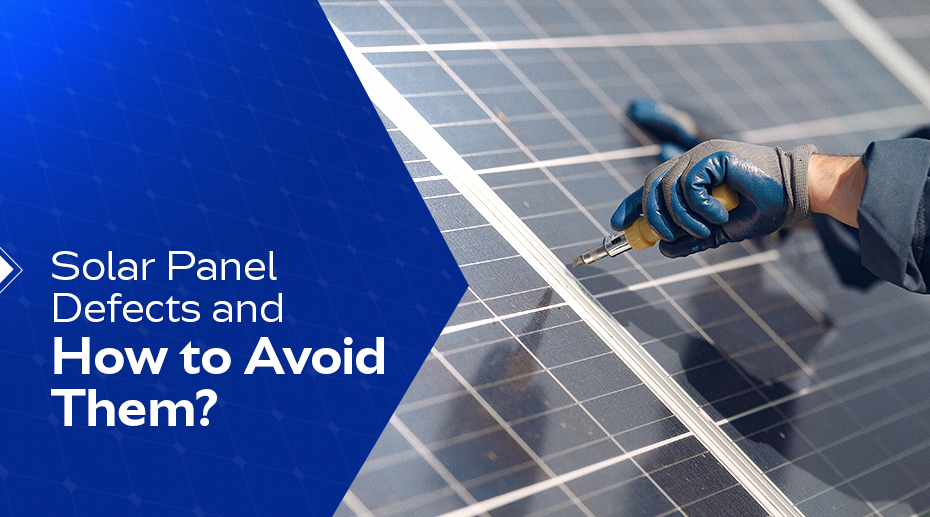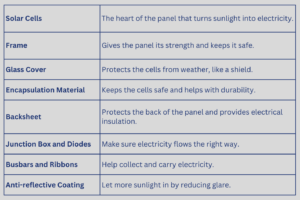Solar Panel Defects & How to Avoid Them?

You know, it’s like when your favorite mug has a crack, it’s still usable, but still, it just doesn’t feel the same. This could be said for solar panels, as well. There could be a defect; maybe a small crack, perhaps a loose connection, or some obstruction on the surface; on these occasions, they do not perform as they are supposed to. They may not be delivering the full energy; instead, you are getting this pathetic trickle.
Imagine filling up a bucket that has holes in it; you just think, “Oh, that’s not much of a problem,” but all those tiny things can add up over time. Now you’re left with your panel producing fewer and fewer units, scratching your head and wondering what is going on. Keep an eye out. Remember, a stitch in time saves nine, right?
Components of Solar Panels
Understanding what a solar panel is made of is important to understand its defects and damages. Let’s understand a few of them:

Common Solar Panel Defects
Solar panels are amazing inventions that help us capture the power of the sun, but like anything else, they’re not perfect. Sometimes, little issues can pop up that affect how well they work. Think of it like a car with a flat tire — it might still move, but it’s not going anywhere fast! Let’s look at 10 common defects and how they can throw a wrench in the works:
Cracked Solar Cells
Imagine dropping your favorite plate — even a tiny crack can ruin it. Solar cells are the same. Cracks can form because of heavy pressure, bad handling, or extreme weather changes. These cracks may not look like much, but they mess with how the cells convert sunlight into electricity. Over time, even small cracks can grow and cause bigger problems.
Delamination
Ever seen a sticker peeling off its surface? That’s what delamination looks like in a solar panel. The layers inside the panel start separating, which lets in air and moisture. This weakens the panel and can cause corrosion. When this happens, it’s like your raincoat getting a tear — it can’t protect you properly anymore.
Discoloration
Have you noticed how a bright, colorful t-shirt fades after too much time in the sun? Solar panels can also lose their shine. Discoloration happens because of UV rays or poor-quality materials. When the panel turns yellow or brown, it blocks sunlight, which means less energy for you.
Hot Spots
Hot spots are like that one hot burner on your stove — it gets way too hot while the rest stay cool. They happen when certain parts of the panel don’t get enough airflow or are shaded. These areas heat up more than others, causing damage over time. It’s like overworking one part of your body while the rest sits idle — it’s not sustainable.
Solar Diode Failure
Think of diodes as traffic cops in the solar panel system. They direct the flow of electricity to make sure everything runs smoothly. But if a diode fails, it’s like a traffic light stuck on red — everything grinds to a halt. This can lower the efficiency of the entire panel.
Loose or Corroded Wiring
Loose wiring in a solar panel is like having a loose lightbulb — it flickers or doesn’t work at all. Over time, exposure to rain, humidity, or temperature changes can corrode the wires, cutting off the electricity flow. No wires, no power!
Glass Breakage
The glass on top of a solar panel is tough, but it’s not indestructible. If something heavy falls on it or a hailstorm comes through, the glass can crack or shatter. This doesn’t just look bad; it also leaves the cells exposed to the elements, which can cause more damage.
Snail Trails
No, it’s not an actual snail crawling across your panel! Snail trails are small, silvery lines that appear on the surface of the panel over time. They don’t look like much, but they’re a sign of internal damage. It’s like seeing rust on a bike — it tells you something’s wearing out.
PID (Potential Induced Degradation)
This one sounds fancy, but it’s just a problem caused by voltage stress on the panel. Over time, the electrical charge can damage the cells, making the panel produce less energy. It’s like a battery that slowly loses its ability to hold a charge.
Weather Damage
Solar panels are designed to handle weather, but sometimes Mother Nature gets the upper hand. Hailstorms, heavy winds, or even too much heat can wear them down. Panels can bend, warp, or lose efficiency over time. It’s like leaving your favorite shoes in the rain — they won’t last as long if they’re not protected.
Conclusion
So, let’s take this opportunity to recap: we have seen common problems that solar panels face-some of these include forms of micro cracks, moisture entering through the panels, or a backsheet malfunctioning that inhibits energy generation. An itch here, an itch there-like a tiny leak on a boat that later becomes a huge problem if it isn’t repaired in time.
Now, good news! Most of these issues can at least be avoided, if not fixed, given the right materials from the start. This is where Vishakha Renewables comes in. We won’t make products that perform great today and perform badly tomorrow; we are about providing long-term solutions.
Now you’re not only buying material but also investing in quality, reliability, and peace of mind that your panels will keep delivering day after day-and isn’t that what we all need?
Keep Reading
Tips and Recommendation for Solar Panel Maintenance
Types of Solar Backsheet in Solar Panel
